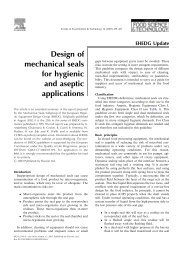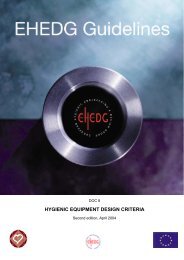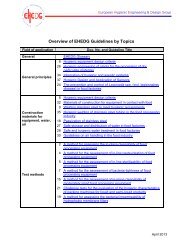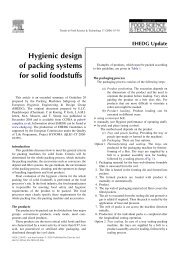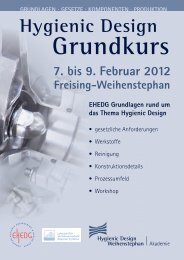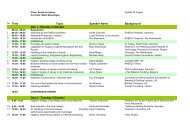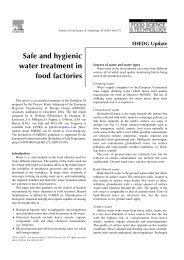Yearbook 2013/2014 - ehedg
Yearbook 2013/2014 - ehedg
Yearbook 2013/2014 - ehedg
You also want an ePaper? Increase the reach of your titles
YUMPU automatically turns print PDFs into web optimized ePapers that Google loves.
24 The importance of hygienic design: A process facility case study and checklist<br />
Phase 4. Project Commission:<br />
Accept and installation<br />
This is the last phase of the project. Once this phase<br />
is completed, the installation will be approved by all of<br />
the functions involved and production can begin. The<br />
commissioning, under a sanitation point of view, consists of:<br />
• An entire review of the hygienic design of the<br />
installation once it is completely built.<br />
• Validation of the effectiveness of the cleaning<br />
(e.g., visual inspection + swabbing, enzyme-linked<br />
immunosorbent assay [ELISA]) during the start-up<br />
phase.<br />
• Training of the operators on how to clean the new<br />
installation.<br />
After the line has been running for a certain period of time,<br />
the site acceptance test (SAT) will take place to approve the<br />
final handover of the installation to the plant. During the SAT,<br />
a complete tear-down of the line will be carried out by the<br />
sanitation team to confirm the absence of product residues,<br />
biofilms, allergen residues, and other potential contaminants.<br />
This verification will be performed using the same tools used<br />
in the start-up phase.<br />
Conclusion<br />
• In addition to the takeaway messages that can<br />
be gleaned from this example of the application<br />
of hygienic design principles to the design and<br />
construction of a cream cheese manufacturing facility,<br />
there are some that are worth reiterating:<br />
• Allocate the proper amount of time/resources for the<br />
feasibility and pre-engineering phases. The more the<br />
work is developed during these phases, the higher the<br />
likelihood of successful implementation of the project.<br />
• Sanitary design expertise has to be present in the FAT<br />
in order to identify potential sanitary design issues that<br />
equipment suppliers should modify before bringing the<br />
systems on site.<br />
• During the execution phase it is really important to<br />
perform a frequent (i.e., daily) assessment of the<br />
building and processing areas to identify potential<br />
design “issues” that can still be fixed at this stage but<br />
not in further stages in the process.<br />
• Unexpected “surprises” may arise during the execution<br />
and commissioning phase. Be ready to proactively<br />
look for feasible alternatives that can be implemented<br />
without significant impact to the efficiency of the line.



